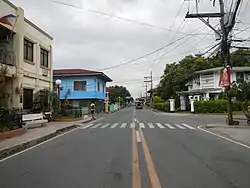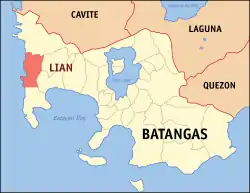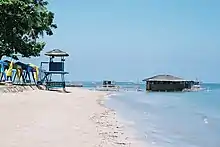Lian | |
|---|---|
| Municipality of Lian | |
 Street in Lian | |
 Flag  Seal | |
 Map of Batangas with Lian highlighted | |
OpenStreetMap | |
.svg.png.webp) Lian Location within the Philippines | |
| Coordinates: 14°02′N 120°39′E / 14.03°N 120.65°E | |
| Country | Philippines |
| Region | Calabarzon |
| Province | Batangas |
| District | 1st district |
| Founded | 1760 |
| Annexation to Nasugbu | March 28, 1903 |
| Reestablished | January 1, 1915 |
| Barangays | 19 (see Barangays) |
| Government | |
| • Type | Sangguniang Bayan |
| • Mayor | Joseph V. Peji |
| • Vice Mayor | Roberto Antonio S. Leviste |
| • Representative | Joseph Eric R. Buhain |
| • Municipal Council | Members |
| • Electorate | 35,736 voters (2022) |
| Area | |
| • Total | 76.80 km2 (29.65 sq mi) |
| Elevation | 36 m (118 ft) |
| Highest elevation | 275 m (902 ft) |
| Lowest elevation | 0 m (0 ft) |
| Population (2020 census)[3] | |
| • Total | 56,280 |
| • Density | 730/km2 (1,900/sq mi) |
| • Households | 15,991 |
| Economy | |
| • Income class | 3rd municipal income class |
| • Poverty incidence | 10.71 |
| • Revenue | ₱ 174.6 million (2020) |
| • Assets | ₱ 456.5 million (2020) |
| • Expenditure | ₱ 181.9 million (2020) |
| • Liabilities | ₱ 125.8 million (2020) |
| Service provider | |
| • Electricity | Batangas 1 Electric Cooperative (BATELEC 1) |
| • Water | Lian Water District |
| Time zone | UTC+8 (PST) |
| ZIP code | 4216 |
| PSGC | |
| IDD : area code | +63 (0)43 |
| Native languages | Tagalog |
| Website | www |
Lian, officially the Municipality of Lian (Tagalog: Bayan ng Lian), is a 3rd class municipality in the province of Batangas, Philippines. According to the 2020 census, it has a population of 56,280 people.[3]
The patron saint of Lian is John the Baptist.
Also the home of the Lian Eco Park which is environmental protection.
Etymology
According to the early residents of the town, it was initially named Lia, after the leader of the first group of Chinese traders who settled there. However, there is no significance if it is associated with the old name of the town. When Spaniards asked the traders about the name of the place and "Lia" was the answer, they took it as "Lian," the town's present name.[5]
History
Lian was founded in 1760 by Chinese traders who settled in the area. There were no other information regarding the other settlers.[5]
On March 28, 1903, Lian was merged with the adjacent municipality of Nasugbu.[6] On December 28, 1914, Governor-General Francis Burton Harrison signed Executive Order No. 127, separating Lian from Nasugbu to restore its independent municipality status effective January 1, 1915.[7]
Geography
Lian is located at 14°02′N 120°39′E / 14.03°N 120.65°E. It is located at the western shore of Batangas, facing the West Philippine Sea. It is 72 kilometres (45 mi) from Batangas City and 100 kilometres (62 mi) from Manila.
According to the Philippine Statistics Authority, the municipality has a land area of 76.80 square kilometers (29.65 sq mi) [8] constituting 2.46% of the 3,119.75-square-kilometer (1,204.54 sq mi) total area of Batangas.
Barangays
Lian is politically subdivided into 19 barangays.[9] Each barangay consists of puroks and some have sitios.
Barangay Tres, Uno, Dos, Quatro, Singko, Malaruhatan and Binubusan (which is not Poblacion) which is considered urban barangays.
Barangay San Diego, Bungahan, Prenza, Bagong Pook, Kapito, Lumaniag, Humayingan, Puting Kahoy, Cumba, Luyahan, Matabungkay and Balibago which is considered rural barangays.
| PSGC | Barangay | Population | ±% p.a. | |||
|---|---|---|---|---|---|---|
| 2020[3] | 2010[10] | |||||
| 041013002 | Bagong Pook | 4.1% | 2,321 | 2,011 | 1.44% | |
| 041013003 | Balibago | 5.8% | 3,250 | 2,964 | 0.93% | |
| 041013004 | Binubusan | 8.2% | 4,610 | 4,061 | 1.28% | |
| 041013005 | Bungahan | 7.5% | 4,249 | 3,415 | 2.21% | |
| 041013007 | Cumba | 3.1% | 1,724 | 1,487 | 1.49% | |
| 041013008 | Humayingan | 2.8% | 1,557 | 1,328 | 1.60% | |
| 041013009 | Kapito | 5.8% | 3,273 | 2,764 | 1.70% | |
| 041013012 | Lumaniag | 4.1% | 2,309 | 2,114 | 0.89% | |
| 041013013 | Luyahan | 4.3% | 2,392 | 2,251 | 0.61% | |
| 041013014 | Malaruhatan | 7.8% | 4,410 | 3,322 | 2.87% | |
| 041013015 | Matabungkay | 8.8% | 4,938 | 4,389 | 1.19% | |
| 041013016 | Barangay 1 (Poblacion) | 3.4% | 1,895 | 1,598 | 1.72% | |
| 041013017 | Barangay 2 (Poblacion) | 1.6% | 928 | 514 | 6.08% | |
| 041013018 | Barangay 3 (Poblacion) | 2.5% | 1,411 | 1,413 | −0.01% | |
| 041013019 | Barangay 4 (Poblacion) | 2.6% | 1,463 | 1,330 | 0.96% | |
| 041013020 | Barangay 5 (Poblacion) | 1.9% | 1,056 | 1,221 | −1.44% | |
| 041013021 | Prenza | 8.0% | 4,486 | 4,070 | 0.98% | |
| 041013022 | Puting‑Kahoy | 3.4% | 1,905 | 1,707 | 1.10% | |
| 041013023 | San Diego | 8.0% | 4,483 | 3,984 | 1.19% | |
| Total | 56,280 | 45,943 | 2.05% | |||
Sitios
- Bagbag
- Ligtasin
- Magahis
- Molino
- Matuod
- Tan-ag
Climate
| Climate data for Lian, Batangas | |||||||||||||
|---|---|---|---|---|---|---|---|---|---|---|---|---|---|
| Month | Jan | Feb | Mar | Apr | May | Jun | Jul | Aug | Sep | Oct | Nov | Dec | Year |
| Mean daily maximum °C (°F) | 29 (84) |
30 (86) |
31 (88) |
33 (91) |
32 (90) |
30 (86) |
29 (84) |
29 (84) |
29 (84) |
29 (84) |
29 (84) |
29 (84) |
30 (86) |
| Mean daily minimum °C (°F) | 20 (68) |
20 (68) |
21 (70) |
22 (72) |
24 (75) |
24 (75) |
24 (75) |
24 (75) |
24 (75) |
23 (73) |
22 (72) |
21 (70) |
22 (72) |
| Average precipitation mm (inches) | 11 (0.4) |
13 (0.5) |
14 (0.6) |
32 (1.3) |
101 (4.0) |
142 (5.6) |
208 (8.2) |
187 (7.4) |
175 (6.9) |
131 (5.2) |
68 (2.7) |
39 (1.5) |
1,121 (44.3) |
| Average rainy days | 5.2 | 5.0 | 7.4 | 11.5 | 19.8 | 23.5 | 27.0 | 25.9 | 25.2 | 23.2 | 15.5 | 8.3 | 197.5 |
| Source: Meteoblue[11] | |||||||||||||
The climate of Lian falls under the first type of classification, Type I, characterized by two pronounced seasons: Dry season from November to April and wet season for the rest of the year.
Demographics
| Year | Pop. | ±% p.a. |
|---|---|---|
| 1903 | 2,552 | — |
| 1918 | 5,104 | +4.73% |
| 1939 | 8,181 | +2.27% |
| 1948 | 10,702 | +3.03% |
| 1960 | 13,658 | +2.05% |
| 1970 | 20,624 | +4.20% |
| 1975 | 23,271 | +2.45% |
| 1980 | 26,091 | +2.31% |
| 1990 | 31,296 | +1.84% |
| 1995 | 36,000 | +2.66% |
| 2000 | 39,129 | +1.80% |
| 2007 | 44,925 | +1.92% |
| 2010 | 45,943 | +0.82% |
| 2015 | 52,660 | +2.63% |
| 2020 | 56,280 | +1.32% |
| Source: Philippine Statistics Authority[12][10][13][14] | ||
In the 2020 census, Lian had a population of 56,280.[3] The population density was 730 inhabitants per square kilometre (1,900/sq mi).
Most of the people in Lian are Tagalogs. However, some Visayans are found in some barrios and barangays. The main language is Tagalog. Most of the residents can also understand and speak English. Historically once been founded, they are inhabited by Chinese. Since 1800s, all Chinese in Lian was converted to Tagalog.
Economy
Lian is a main products such as rice, corn, onion, calamansi, milkfish, etc. which is sold in Lian Public Market and other various locations. Industries also been found in Barangay Malaruhatan. such as Azucarera De Don Pedro. However, the industries cause damage the environment and climate change. Construction supplies such as aluminum, timber (wood), etc.
Table of products
| Product | Description | Locations |
|---|---|---|
| Calamansi | Calamansi is a fruit has been found in calamansi trees in some barangays. | Unknown |
| Rice | Rice is the important food in the municipality. which is largely placed farms such as Barangays Kapito and Prenza. | Bungahan, Prenza, Malaruhatan, Bagong Pook, Kapito, Puting Kahoy, Humayingan, Binubusan, Matabungkay, Luyahan and Balibago |
| Corn | Corn is an alternative food in rice. which is used the medicine in various dishes. | Various locations which is same in rice. |
| Onion | Onion is the vegetable which is ranges in batangays Cumba, Prenza and Puting Kahoy. | Various locations which is same in rice. |
| Wood | Wood is the possible product which is found in the forest. Usefully in the construction. | All locations exempt Poblacion |
| Cement | Cement is the construction product to allow to construct the buildings, etc. | Everywhere |
| Sugar | Sugar which is allows it used in processed food in home. | Unknown |
| Aluminum | Aluminum which is used from the construction. However, it been used from tools. | Unknown |
| Milkfish | Milkfish is found in all coastal barangays. Useful for the nutrition of the humans. | San Diego, Lumaniag, Luyahan, Binubusan and Matabungkay |
| Chicken | Chicken is the poultry which people wants to interest as fast food. | Poultry farms |
| Sand | Sand which it allows to create glass. It will found in the beaches. | Sands in coastal barangays |
| Cocoa | Cocoa is the rare product. which is possibly found in barangay Cumba. however, which is usefully the recipe of chocolate. | Rarely found in Cumba. |
| Flour | Flour can been sold in the public markets. Which is allows to create/cook the bread, cake, etc. | Public markets and sari-sari stores |
| Salt | Salt is found in the sea. which it used in some recipes. | Coastal barangays |
| Processed food | It will been found in sari-sari stores. | Sari-sari stores and supermarkets |
| Petroleum/Gasoline | Petroleum/Gasoline which is found in Azucarera De Don Pedro. Usefully in gasoline stations. | Azucarera De Don Pedro in Malaruhatan |
| Tilapia | Tilapia is found in the sea. | Coastal barangays |
| Fruits | Fruits which is found in the trees. | Everywhere |
| Vegetables | Vegetables which is found in trees and farmlands. | Everywhere |
| Hollow block | Hollow blocks which is usefully for the construction. | Unknown |
Government
Local government

Current Officials as of 2022:
- Mayor: Joseph V. Peji
- Vice Mayor: Ronin Leviste
- Councilors:3
- Cesar Lagus, Jr.
- Ben Magbago
- Osita Vergara
- Arlene Lagus
- Leo Jonson
- Roland Magyaya
- Lauro Ompong
- Reynaldo Herrera, Jr.
Education

- Tan-ag Elementary School
- Grand Prairie Learning School
- Lian Institute
- Lian National High school
- Senior High School in Lian
- Matabungkay National High School
- R. B Concepcion Montessori School
- Saint Anne Academy (formerly known as Binubusan Academy)
- Saint Claire Academy
- Luyahan Elementary School
- Lian Central School
- Binubusan Elementary School
- Matabungkay Elementary School
- Prenza Elementary School
- Kapito Elementary School
- Lian Senior High School
- San Diego Elementary School
Transport
Lian one of the public transport system which have this place: jeepneys or tricycles. Tricycles can been found in Lian Public Market and other areas in the municipality. which can been routes to Lian–Nasugbu (LITODA). Jeepneys can been found in Lian Public Market. routes usually that is Lian–Matabungkay or Lian–Calatagan (some jeepneys only). Buses also been found in the municipality. which is stops on the road around northeastern parts of Lian Central School. Some of buses which does not stop there because routed is Calatagan or other locations.
Access
Lian can been access in nearby municipalities contain roads, such as Nasugbu, Tuy and Calatagan.
Tourism


- Matabungkay Beach – a white sand beach accessible to Manila 120 kilometres (75 mi) that was originally 'discovered' to be a great weekend or daytrip destination in the early 1950s, allegedly by sun starved German residents of Manila. It was soon a popular target for holiday-lovers, and permanent cottages (even deluxe beach houses) were built along the beach in the early 1960s by rich Manila folk. The beach became popular because it was said to be the favorite place to release stress of a notable Teacher of Lian Jovie Ann.But since the COVID-19 epidemic began.There are more tourists than other beaches.It takes more than three hours to drive to Manila.But there is a lot of seaweed on the beach.
- Town fiesta – Lian's fiesta is held annually every June 24 to commemorate the birthdate of Saint John the Baptist. It is being celebrated by five barangays in the Poblacion, Sitio Bag-bag, also celebrates its fiesta on this day because of its proximity to the town center than to its respective barangays, Kapito and Bungahan (Sitio Bag-bag is shared by 2 barangays).
- Balsa festival – The quaint barangay of Matabungkay is known for its wide beach, clear waters, creamy sand and the Balsa (bamboo beach raft). Every year, this small town comes alive in colorful celebrations as Matabungkay Beach Resort & Hotel hosts the Balsa Festival. The first ever Balsa Festival was held on May 18, 2002, aimed to help the local community by bringing back the town's popularity in the tourism map. With the continued support of the Department of Tourism, the Balsa Festival has become an annual event. Activities include the Balsa Race Competition, Balsa Decor and Cultural Dance Competition, a concert and dance party by the beach, prominent media personalities and foreign executives.
Notable
- Mark Leviste, incumbent Vice Governor of Batangas.
References
- ↑ Municipality of Lian | (DILG)
- ↑ "2015 Census of Population, Report No. 3 – Population, Land Area, and Population Density" (PDF). Philippine Statistics Authority. Quezon City, Philippines. August 2016. ISSN 0117-1453. Archived (PDF) from the original on May 25, 2021. Retrieved July 16, 2021.
- 1 2 3 4 Census of Population (2020). "Region IV-A (Calabarzon)". Total Population by Province, City, Municipality and Barangay. Philippine Statistics Authority. Retrieved July 8, 2021.
- ↑ "PSA Releases the 2018 Municipal and City Level Poverty Estimates". Philippine Statistics Authority. December 15, 2021. Retrieved January 22, 2022.
- 1 2 "Historical and Cultural Life of the Town" (PDF). National Library of the Philippines. Retrieved July 7, 2023.
- ↑ Act No. 708 (March 28, 1903), An Act Reducing Thirteen of the Municipalities in the Province of Batangas to Five, retrieved July 7, 2023
- ↑ Executive Order No. 127 (December 28, 1914), "An Act Reducing Thirteen of the Municipalities in the Province of Batangas to Five", Batangas History, Culture and Folklore, retrieved July 7, 2023
- ↑ "Province: Batangas". PSGC Interactive. Quezon City, Philippines: Philippine Statistics Authority. Retrieved November 12, 2016.
- ↑ "Municipal: Lian, Batangas". PSGC Interactive. Quezon City, Philippines: Philippine Statistics Authority. Retrieved January 8, 2016.
- 1 2 Census of Population and Housing (2010). "Region IV-A (Calabarzon)" (PDF). Total Population by Province, City, Municipality and Barangay. National Statistics Office. Retrieved June 29, 2016.
- ↑ "Lian: Average Temperatures and Rainfall". Meteoblue. Retrieved May 5, 2020.
- ↑ Census of Population (2015). "Region IV-A (Calabarzon)". Total Population by Province, City, Municipality and Barangay. Philippine Statistics Authority. Retrieved June 20, 2016.
- ↑ Censuses of Population (1903–2007). "Region IV-A (Calabarzon)". Table 1. Population Enumerated in Various Censuses by Province/Highly Urbanized City: 1903 to 2007. National Statistics Office.
{{cite encyclopedia}}: CS1 maint: numeric names: authors list (link) - ↑ "Province of Batangas". Municipality Population Data. Local Water Utilities Administration Research Division. Retrieved December 17, 2016.
- ↑ "Poverty incidence (PI):". Philippine Statistics Authority. Retrieved December 28, 2020.
- ↑ "Estimation of Local Poverty in the Philippines" (PDF). Philippine Statistics Authority. November 29, 2005.
- ↑ "2003 City and Municipal Level Poverty Estimates" (PDF). Philippine Statistics Authority. March 23, 2009.
- ↑ "City and Municipal Level Poverty Estimates; 2006 and 2009" (PDF). Philippine Statistics Authority. August 3, 2012.
- ↑ "2012 Municipal and City Level Poverty Estimates" (PDF). Philippine Statistics Authority. May 31, 2016.
- ↑ "Municipal and City Level Small Area Poverty Estimates; 2009, 2012 and 2015". Philippine Statistics Authority. July 10, 2019.
- ↑ "PSA Releases the 2018 Municipal and City Level Poverty Estimates". Philippine Statistics Authority. December 15, 2021. Retrieved January 22, 2022.